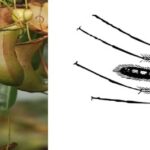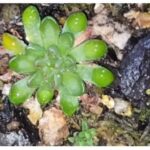As an Amazon Associate, this site earns commissions from qualifying purchases. For more details, click here.
Venus flytraps are known for eating flies and spiders, but what about gnats? Can we use these carnivorous plants to keep these pests away? Or are gnats going to cause trouble for your plant? These are all good questions and this article will provide the answers you need.
Venus flytraps eat gnats as well as other small insects. But these plants are not effective repellents because they only have a few traps, and it takes several days to digest a single gnat.
Why Do Venus Flytraps Eat Gnats Anyway?
Venus flytraps do not catch insects just for food. They get energy from the sun because just like all plants, Venus flytraps use photosynthesis to make their own food. So why do they eat bugs?
Venus flytraps eat gnats because they are rich in nitrogen, phosphorus and sulfur. These elements serve as nutrients that help Venus flytraps grow large traps and stay healthy.
Carnivorous plants do not actually eat insects the way animals do. First we need to understand how Venus flytraps grow in nature.
Venus flytraps are found in poor soil conditions. In nature they only grow in the swamps of North and South Carolina, in soil that would kill other plants.
These plants can create food through photosynthesis, but they need additional nutrients to grow. This is where gnats and other insects come into play.
While Venus flytraps are not sentient, they can sense which insects are rich in nitrogen and other important nutrients. Gnats have many of these elements that Venus flytraps need so it is one of their main sources of nourishment.
Venus flytraps consume gnats not because they are a nuisance but because they are nutritious. Most carnivorous plants grow in poor soil so they resort to other means of acquiring nutrients.
The traps on a Venus flytrap are capable of eating gnats and other insects. As will be explained in the next section, adult gnats are a good food source though their larvae can be problematic.
Gnats are drawn to Venus flytraps the same way as other insects. The nectar produced by he plant lures the gnat close to the trap.
You do not have to feed gnats to Venus flytraps. Ants, spiders, flies even mealworms and Kaytee Koi’s Choice Koi Floating Fish Food are sufficient. But if you see one of its traps has caught a gnat, it does so to sustain growth.
Are Venus Flytraps Effective Gnat Controllers?
Venus flytraps eat gnats, but with only 5-10 traps at a time on average, they can only catch a few of these. Venus flytraps is good for catching the occasional gnats, but for swarms you need to use other bug controllers.
While Venus flytraps do not have eyes, their trap sensors do an excellent job of detecting bugs. But most can only grow a few traps at a time. Some really big Venus flytraps might have 10-20 traps simultaneously, but that is rare.
Usually a Venus flytrap eat about 1-4 insects a month. If there are plenty of gnats the traps will catch more. But a swarm of them is too much unless you have several carnivorous plants in your home.
A Venus flytrap takes 5-12 days to consume one insect. It uses a lot of energy to do so and if you force the traps to consume several gnats at once, it could damage the plant.
Carnivorous plants can be used to repel fruit flies for example, or keep pests away from food. A few gnats yes. But if there are several you are better off using other methods.
One way to get rid of gnats is to use insect repellent like Summit Gnat Spray. With this product you do not have to rely on your Venus flytrap. If you have several grown carnivorous plants, they can serve as deterrent in a limited capacity.
But a far better approach is to find out what is drawing the gnats. Venus flytraps are only a temporary solution so find out what lures them and how to prevent it.
Gnats are drawn by moisture, leftover food, open garbage cans damp areas, clogged gutters and any area with standing water.
Keep your home clean and dry any moist areas around your property. That should be enough to keep them at bay. If you have fruit trees, you can place several carnivorous plants nearby.
Are Fungus Gnats Harmful to Venus Flytraps?
Mature fungus gnats will not cause any trouble, but their larvae can harm Venus flytraps especially young ones. Adult Venus flytraps are not vulnerable and consume gnats for nutrients.
If fungus gnat larvae get near a young Venus flytrap, they will consume the leaves and the roots. The plant becomes susceptible to fungal infection.
Gnats can be a problem if you are growing any type of carnivorous plant. They are dark colored and drawn to soggy soil, so do not overwater the plant.
Gnat larvae usually eat organic materials in soil, but they also feed on leaves, stems and roots of plants, especially young Venus flytraps. Left untreated, the larvae will spread diseases, slowing the growth of Venus flytraps drastically.
Gnat larvae infection can be prevented by applying Bacillus thuringiensis on the soil. This destroys the larvae The key is to have the soil moist at all times, but not drenched.
If one of your Venus flytraps has been infected, isolate it from the rest. This will keep damage to a minimum and give you time to get rid of the larvae.
You can also put coarse sand on top of the soil to keep gnats away. About 1/3 inch is enough. Lastly, do not place Venus flytraps too close together. Plants that are spaced apart will discourage fungal growth and keep larvae at bay.
These suggestions will also work for sundews, butterworts and other carnivorous plants. As always, prevention is better than treatment.
To keep it simple: adult Venus flytraps will not be harmed by gnats. If you see a trap catch a gnat, there is nothing to worry about.
It only becomes a concern if you are just starting to grow a Venus flytrap or it is coming out of dormancy. The plant is vulnerable so make sure to follow the advice given here.
What Happens When a Venus Flytrap Eats Gnats?
The traps of a Venus flytrap can close a limited number of times, so the plant has several measures in place to minimize waste.
The process starts when a gnat is lured by nectar. The traps have sensors that signal to the plant the presence of prey. Once they activate, the trap shuts quickly to ensnare it.
The more the gnat struggles, the tighter the leaves compress together. Eventually the trap squeezes the air out of the bug.
Venus flytraps eat gnats using special enzymes. While most animals can digest food in hours, it takes a Venus flytrap up to two weeks to eat one insect.
The plant uses so much energy that it cannot photosynthesize while eating an insect. It is a good tradeoff though because it is receiving nutrients.
And this is why you should not overfeed a Venus flytrap. It has to spend a lot of energy to do so. If you fill all the traps with gnats, there will be more energy getting out than coming in.
A Venus flytrap digests gnats the same way it does any other insect. While 5-12 days is the typical digestion period, it could take more or less time.
A healthy Venus flytrap might consume gnats faster. On the other hand a sickly plant would take longer to digest it. This is true not just for Venus flytraps but also for other carnivorous plants in general.
Remember, if your Venus flytrap is outdoors there is no reason to feed it gnats as there are many flying and crawling insects out there.
Conclusion
Venus flytraps are not effective gnat controllers because that is not what they do. Instead we should think of gnats as nutrient sources for these plants, and as shown here there are other ways to get rid of these insects..

My fascination with carnivorous plants began many, many years ago with Venus Fly Traps. Now I am more than happy to impart what I know with other enthusiasts and those who are curious about meat eating plants.



